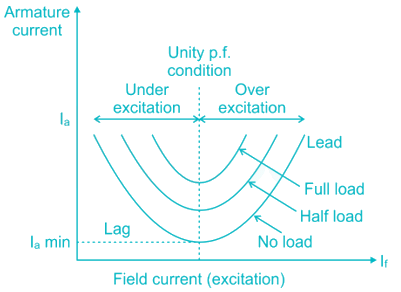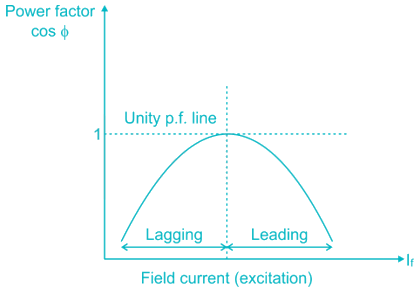Electrical Engineering (EE) Exam > Electrical Engineering (EE) Questions > A synchronous motor connected to infinite bus...
Start Learning for Free
A synchronous motor connected to infinite bus-bars has constant full-load, 100% excitation and unity p.f. On changing the excitation alone, the excitation current will have
- a)Leading p.f with under-excitation
- b)Leading p.f. with over-excitation
- c)Lagging p.f. with over-excitation
- d)No change in p.f.
Correct answer is option 'B'. Can you explain this answer?
| FREE This question is part of | Download PDF Attempt this Test |
Verified Answer
A synchronous motor connected to infinite bus-bars has constant full-l...
From the V curves and inverted V curves, we can say that the excitation current will have leading power factor with over excitation and lagging power factor with under excitation.


Most Upvoted Answer
A synchronous motor connected to infinite bus-bars has constant full-l...
Introduction:
In a synchronous motor connected to infinite bus-bars, the motor operates at a constant full-load, 100% excitation, and unity power factor. When the excitation of the motor alone is changed, the excitation current will have a leading power factor with over-excitation.
Explanation:
To understand why the excitation current has a leading power factor with over-excitation, let's consider the following points:
Unity Power Factor:
When the synchronous motor is connected to infinite bus-bars, it operates at unity power factor. This means that the motor draws a current from the bus-bars that is in phase with the bus voltage.
Effect of Excitation on Power Factor:
The excitation of a synchronous motor determines the magnitude and phase angle of the rotor field. By changing the excitation, we can control the reactive power flow in the motor.
Under-Excitation:
Under-excitation occurs when the excitation of the motor is less than the full-load value. In this case, the motor operates at a lagging power factor. The excitation current lags behind the bus voltage, and the motor absorbs reactive power from the bus-bars.
Over-Excitation:
Over-excitation occurs when the excitation of the motor is greater than the full-load value. In this case, the motor operates at a leading power factor. The excitation current leads the bus voltage, and the motor supplies reactive power to the bus-bars.
Effect on Power Factor:
When we change the excitation alone, without changing the load conditions, the motor still operates at full load. This means that the mechanical power output and the torque remain constant.
When the excitation is increased beyond the full-load value, the motor operates at a leading power factor. This is because the increased excitation creates a magnetic field that leads the bus voltage. As a result, the motor supplies reactive power to the bus-bars.
Conclusion:
In a synchronous motor connected to infinite bus-bars, when the excitation alone is changed, the excitation current will have a leading power factor with over-excitation. This is because the increased excitation leads to a magnetic field that leads the bus voltage, causing the motor to supply reactive power to the bus-bars.
In a synchronous motor connected to infinite bus-bars, the motor operates at a constant full-load, 100% excitation, and unity power factor. When the excitation of the motor alone is changed, the excitation current will have a leading power factor with over-excitation.
Explanation:
To understand why the excitation current has a leading power factor with over-excitation, let's consider the following points:
Unity Power Factor:
When the synchronous motor is connected to infinite bus-bars, it operates at unity power factor. This means that the motor draws a current from the bus-bars that is in phase with the bus voltage.
Effect of Excitation on Power Factor:
The excitation of a synchronous motor determines the magnitude and phase angle of the rotor field. By changing the excitation, we can control the reactive power flow in the motor.
Under-Excitation:
Under-excitation occurs when the excitation of the motor is less than the full-load value. In this case, the motor operates at a lagging power factor. The excitation current lags behind the bus voltage, and the motor absorbs reactive power from the bus-bars.
Over-Excitation:
Over-excitation occurs when the excitation of the motor is greater than the full-load value. In this case, the motor operates at a leading power factor. The excitation current leads the bus voltage, and the motor supplies reactive power to the bus-bars.
Effect on Power Factor:
When we change the excitation alone, without changing the load conditions, the motor still operates at full load. This means that the mechanical power output and the torque remain constant.
When the excitation is increased beyond the full-load value, the motor operates at a leading power factor. This is because the increased excitation creates a magnetic field that leads the bus voltage. As a result, the motor supplies reactive power to the bus-bars.
Conclusion:
In a synchronous motor connected to infinite bus-bars, when the excitation alone is changed, the excitation current will have a leading power factor with over-excitation. This is because the increased excitation leads to a magnetic field that leads the bus voltage, causing the motor to supply reactive power to the bus-bars.
Attention Electrical Engineering (EE) Students!
To make sure you are not studying endlessly, EduRev has designed Electrical Engineering (EE) study material, with Structured Courses, Videos, & Test Series. Plus get personalized analysis, doubt solving and improvement plans to achieve a great score in Electrical Engineering (EE).

|
Explore Courses for Electrical Engineering (EE) exam
|

|
Similar Electrical Engineering (EE) Doubts
A synchronous motor connected to infinite bus-bars has constant full-load, 100% excitation and unity p.f. On changing the excitation alone, the excitation current will havea)Leading p.f with under-excitationb)Leading p.f. with over-excitationc)Lagging p.f. with over-excitationd)No change in p.f.Correct answer is option 'B'. Can you explain this answer?
Question Description
A synchronous motor connected to infinite bus-bars has constant full-load, 100% excitation and unity p.f. On changing the excitation alone, the excitation current will havea)Leading p.f with under-excitationb)Leading p.f. with over-excitationc)Lagging p.f. with over-excitationd)No change in p.f.Correct answer is option 'B'. Can you explain this answer? for Electrical Engineering (EE) 2024 is part of Electrical Engineering (EE) preparation. The Question and answers have been prepared according to the Electrical Engineering (EE) exam syllabus. Information about A synchronous motor connected to infinite bus-bars has constant full-load, 100% excitation and unity p.f. On changing the excitation alone, the excitation current will havea)Leading p.f with under-excitationb)Leading p.f. with over-excitationc)Lagging p.f. with over-excitationd)No change in p.f.Correct answer is option 'B'. Can you explain this answer? covers all topics & solutions for Electrical Engineering (EE) 2024 Exam. Find important definitions, questions, meanings, examples, exercises and tests below for A synchronous motor connected to infinite bus-bars has constant full-load, 100% excitation and unity p.f. On changing the excitation alone, the excitation current will havea)Leading p.f with under-excitationb)Leading p.f. with over-excitationc)Lagging p.f. with over-excitationd)No change in p.f.Correct answer is option 'B'. Can you explain this answer?.
A synchronous motor connected to infinite bus-bars has constant full-load, 100% excitation and unity p.f. On changing the excitation alone, the excitation current will havea)Leading p.f with under-excitationb)Leading p.f. with over-excitationc)Lagging p.f. with over-excitationd)No change in p.f.Correct answer is option 'B'. Can you explain this answer? for Electrical Engineering (EE) 2024 is part of Electrical Engineering (EE) preparation. The Question and answers have been prepared according to the Electrical Engineering (EE) exam syllabus. Information about A synchronous motor connected to infinite bus-bars has constant full-load, 100% excitation and unity p.f. On changing the excitation alone, the excitation current will havea)Leading p.f with under-excitationb)Leading p.f. with over-excitationc)Lagging p.f. with over-excitationd)No change in p.f.Correct answer is option 'B'. Can you explain this answer? covers all topics & solutions for Electrical Engineering (EE) 2024 Exam. Find important definitions, questions, meanings, examples, exercises and tests below for A synchronous motor connected to infinite bus-bars has constant full-load, 100% excitation and unity p.f. On changing the excitation alone, the excitation current will havea)Leading p.f with under-excitationb)Leading p.f. with over-excitationc)Lagging p.f. with over-excitationd)No change in p.f.Correct answer is option 'B'. Can you explain this answer?.
Solutions for A synchronous motor connected to infinite bus-bars has constant full-load, 100% excitation and unity p.f. On changing the excitation alone, the excitation current will havea)Leading p.f with under-excitationb)Leading p.f. with over-excitationc)Lagging p.f. with over-excitationd)No change in p.f.Correct answer is option 'B'. Can you explain this answer? in English & in Hindi are available as part of our courses for Electrical Engineering (EE).
Download more important topics, notes, lectures and mock test series for Electrical Engineering (EE) Exam by signing up for free.
Here you can find the meaning of A synchronous motor connected to infinite bus-bars has constant full-load, 100% excitation and unity p.f. On changing the excitation alone, the excitation current will havea)Leading p.f with under-excitationb)Leading p.f. with over-excitationc)Lagging p.f. with over-excitationd)No change in p.f.Correct answer is option 'B'. Can you explain this answer? defined & explained in the simplest way possible. Besides giving the explanation of
A synchronous motor connected to infinite bus-bars has constant full-load, 100% excitation and unity p.f. On changing the excitation alone, the excitation current will havea)Leading p.f with under-excitationb)Leading p.f. with over-excitationc)Lagging p.f. with over-excitationd)No change in p.f.Correct answer is option 'B'. Can you explain this answer?, a detailed solution for A synchronous motor connected to infinite bus-bars has constant full-load, 100% excitation and unity p.f. On changing the excitation alone, the excitation current will havea)Leading p.f with under-excitationb)Leading p.f. with over-excitationc)Lagging p.f. with over-excitationd)No change in p.f.Correct answer is option 'B'. Can you explain this answer? has been provided alongside types of A synchronous motor connected to infinite bus-bars has constant full-load, 100% excitation and unity p.f. On changing the excitation alone, the excitation current will havea)Leading p.f with under-excitationb)Leading p.f. with over-excitationc)Lagging p.f. with over-excitationd)No change in p.f.Correct answer is option 'B'. Can you explain this answer? theory, EduRev gives you an
ample number of questions to practice A synchronous motor connected to infinite bus-bars has constant full-load, 100% excitation and unity p.f. On changing the excitation alone, the excitation current will havea)Leading p.f with under-excitationb)Leading p.f. with over-excitationc)Lagging p.f. with over-excitationd)No change in p.f.Correct answer is option 'B'. Can you explain this answer? tests, examples and also practice Electrical Engineering (EE) tests.

|
Explore Courses for Electrical Engineering (EE) exam
|

|
Suggested Free Tests
Signup for Free!
Signup to see your scores go up within 7 days! Learn & Practice with 1000+ FREE Notes, Videos & Tests.
























